Pharm Exec’s 2020 Pipeline Report
Pharmaceutical Executive
Pharrm Exec's 2020 Pipeline Report
From Promise to Progress
Pharm Exec’s 16th Annual Pipeline Report examines six key areas of biopharma R&D-a mix of emerging and maturing-where, for some, promising research efforts are now beginning to pay dividends, as novel advances in science usher in new treatment approaches and curative therapies
Despite entering-or even strengthening already established footing-in today’s “new era of biopharmaceutical innovation,” developing novel drugs that will bring value and benefit to patients continues to be a difficult challenge. The common and very real prospect of failure will never go away. But, as Pharm Exec’s 16th Annual Pipeline Report illustrates, the arduous research efforts by life sciences companies are paying dividends, and
Report methodology; click to enlarge
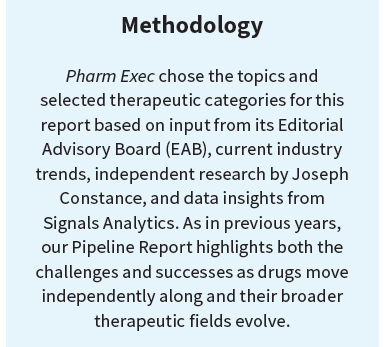
leading to transformative and, in some cases, curative therapies.
For instance, cell and gene therapy (CGT), including CAR-T and the work with RNA interference (RNAi), is beginning to make an impact. The thousands of research papers and patents in areas ranging from CGT, to CRISPR technology, to CAR-T drugs for cancer are a testament that science will continue to breed new successes in product development, and will generate better outcomes for patients and value for the healthcare ecosystem as a whole.
* All figures and tables in this report are provided by Signals Analytics
(To view the report in an interactive pdf format, click
here).
Next-generational cell and gene therapy
More than 3,300 Phase II through IV CGT trials are underway, according to data provided by Signals Analytics, indicating how active R&D efforts are on this front. Oncology, hemophilia, Huntington’s disease, and sickle cell disease, as well as amyotrophic lateral sclerosis (ALS) are among those conditions targeted in clinical trials.
Research efforts include work with pluripotent stem cells (iPS), adeno-associated virus (AAV) gene therapies, and immune tolerance technology, among others. Novartis, Bayer, the National Institutes of Health, and several universities, among other entities, are involved. (Note that CRISPR technology and

CAR-T therapies are the focus of their own sections later in this report.)
In early September, the UK’s National Institute for Health and Care Excellence (NICE) recommended a new gene therapy-based treatment for rare inherited eye disorder for use by the National Health Service. Luxturna (voretigene neparvovec), marketed by Novartis in Europe, is targeted to those who have lost their vision from inherited retinal dystrophy from confirmed RPE65 gene mutations and who have enough viable retinal cells. The RPE65 gene provides instructions for making a protein essential for normal vision. Current treatment involves only supportive care, such as the use of low-vision aids. Clinical trials showed that, in the short term, Luxturna, which is injected directly into the retina, improves vision and prevents worsening of inherited retinal dystrophy.

On another front, Athersys is applying its patented MultiStem stem cell therapy for treating neurological, inflammatory, immune, and cardiovascular diseases, among other indications. For ischemic stroke, the company launched its Masters-2 Phase III pivotal study under special protocol assessment by FDA, and in partnership with Healios, a Phase II/III clinical trial recently commenced in Japan under a new accelerated regulatory framework. MultiStem has priority review designation from Japan’s Pharmaceuticals and Medical Devices Agency. For graft-versus-host disease and hematopoietic stem cell transplantation, a Phase III pivotal study under special protocol assessment has been approved by FDA. The program was awarded orphan-drug status by FDA and the European Medicines Agency (EMA), and is being fast-tracked by FDA. (For more, see and listen to this Pharm Execinterview and podcast with Athersys CEO Gil Van Bokkelen.
In August, Arrowhead Pharmaceuticals and Janssen Pharmaceuticals began dosing in a Phase IIb study of different combination regimens, including JNJ-3989 (formerly ARO-HBV), or JNJ-6379, and a nucleos(t)ide analog for treating chronic hepatitis B virus infection.
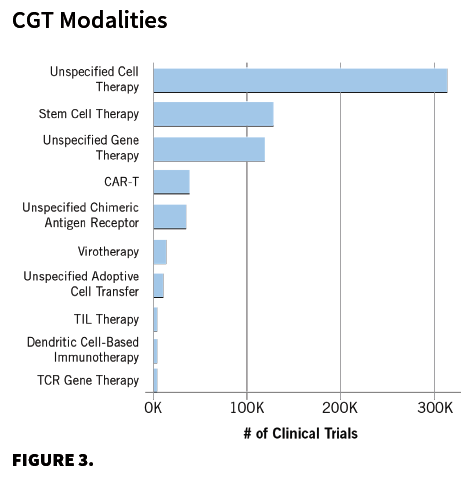
JNJ-3989 is a liver-targeted investigational antiviral therapeutic for subcutaneous injection designed to treat chronic HBV infection by RNAi. JNJ-6379 is an orally administered capsid assembly modulator of the class that forms normal capsid structures.
There also is interest in using cell and gene therapies to treat cystic fibrosis (CF) patients who experience persistent lung infections. There may be curative therapies found in using gene editing or therapy tools in stem cells. If a stem cell receives one of these therapies, every cell that is produced by the stem cell would also have the correct gene. For example, if an airway stem cell had a correct copy of the CF transmembrane conductance regulator (CFTR) gene, the new lung cells produced by that stem cell would also have a correct copy of the CFTR gene.
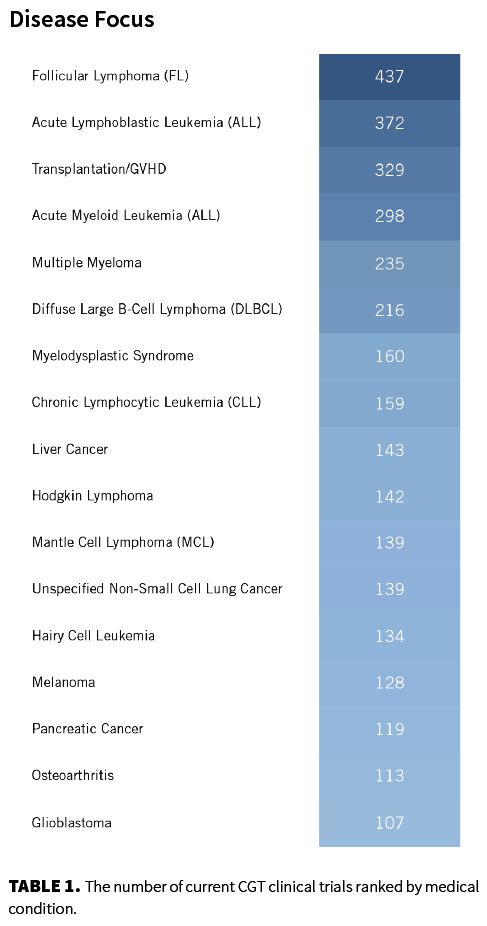
Scientists have shown that it is possible to make iPS cells using cells from people with CF, apply gene editing to correct CFTR mutations in those cells, and reimplant the correct cells into the lungs of CF patients.
Selecta Biosciences wants to combine its immune tolerance technology (ImmTOR) platform with several biologic therapies for rare and serious diseases that require new treatment options due to high immunogenicity. SEL-212, its lead product candidate, is being developed to treat chronic refractory gout patients and resolve their debilitating symptoms, including flares and gouty arthritis.
Abeona Therapeutics’ clinical programs include EB-101, an autologous, gene-corrected cell therapy for recessive dystrophic epidermolysis bullosa, as well as ABO-102 and ABO-101, novel AAV9-based gene therapies for Sanfilippo syndrome types A and B (MPS IIIA and MPS IIIB), respectively.
In August, Orchard Therapeutics announced it will balance its existing contract manufacturing organization (CMO) network with an internal facility to create the infrastructure needed to commercialize its gene therapies.
Orchard’s pipeline of ex vivo autologous gene therapies include five clinical stage programs and the former GlaxoSmithKline hematopoietic stem cell (HSC) gene therapy Strimvelis, which was approved by the EMA in 2016 for treating adenosine deaminase deficiency, an autosomal recessive metabolic disorder that causes immunodeficiency. It is still awaiting FDA approval.
Alnylam is involved in the translation of RNAi into a new class of medicines. The company’s givosiran is an experimental RNAi therapeutic being developed to treat acute hepatic porphyria. In June, Alnylam completed the rolling submission of its new drug application (NDA) for givosiran, and in August, FDA accepted the NDA and granted priority review. The agency has set an action
Click to enlarge
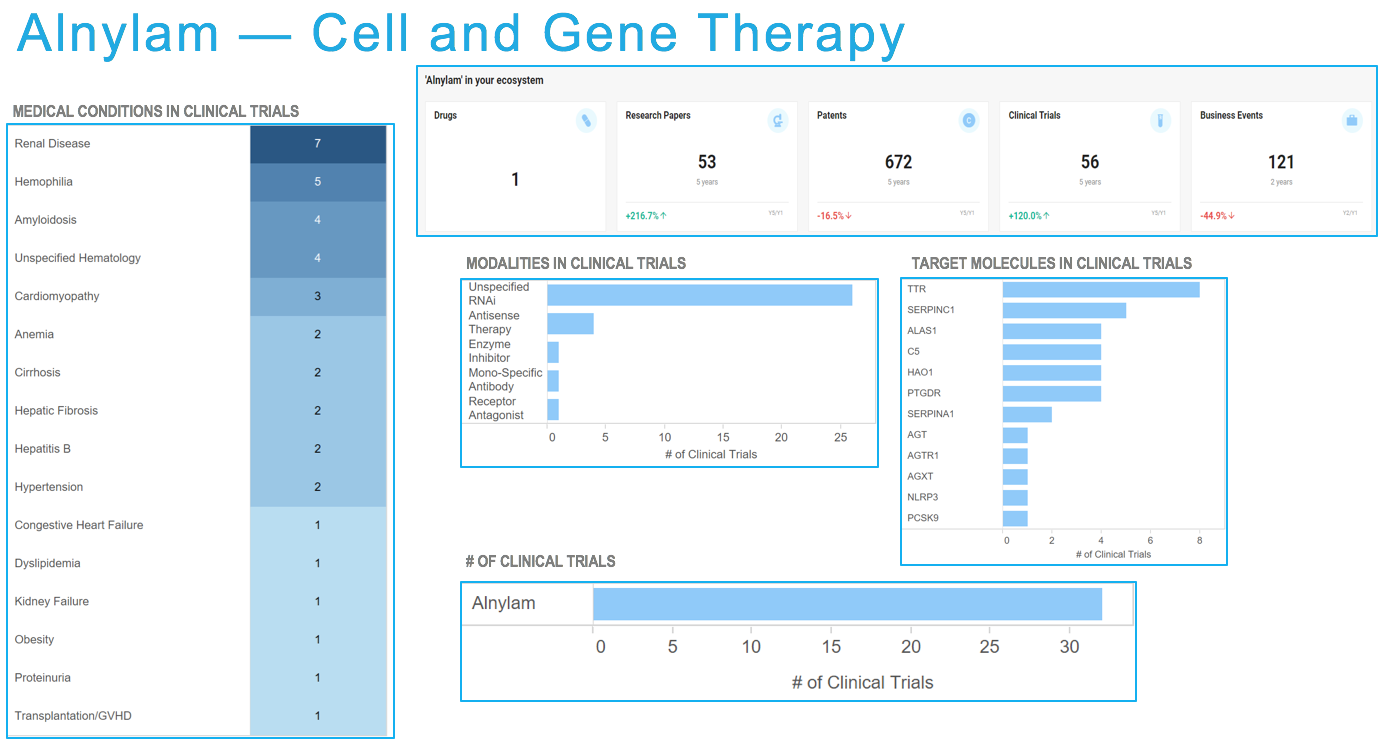
date of Feb. 4, 2020, for givosiran, which is also under regulatory review in Europe.
Lumasiran is Alnylam’s investigational RNAi drug for treating primary hyperoxaluria type I (PH 1). Enrollment continues in Illuminate-A, a global Phase III pivotal study of lumasiran in children and adult PH 1 patients with preserved renal function. Alnylam expects to report top-line results, and if positive, file for global regulatory approvals in early 2020.
Click to enlarge
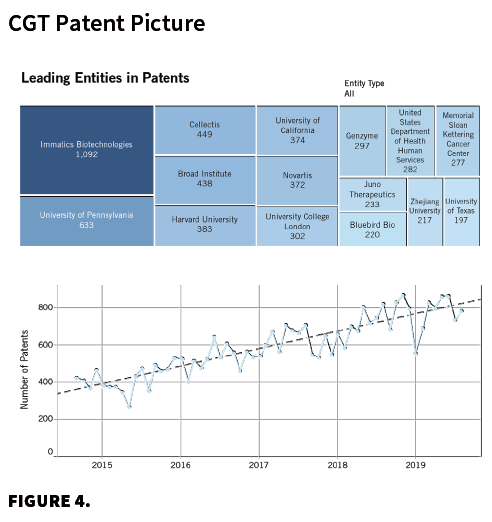
(See Alnylam’s CGT pipeline snapshot above).
Acquisition activity
In notable industry dealmaking centered in the CGT space, Bayer is acquiring BlueRock Therapeutics to build Bayer’s cell therapy pipeline. BlueRock develops cell therapies for neurology, cardiology, and immunology, using a proprietary induced pluripotent stem cell platform called Cell+Gene. A lead program for treating Parkinson’s disease is expected to enter clinical trials by the end of the year. BlueRock was established in a joint venture by Bayer and Versant Ventures in 2016.
Attention to cost
Meanwhile, as an indication of the growing impact of CGT and concerns about its costs, health insurance giant
Click to enlarge
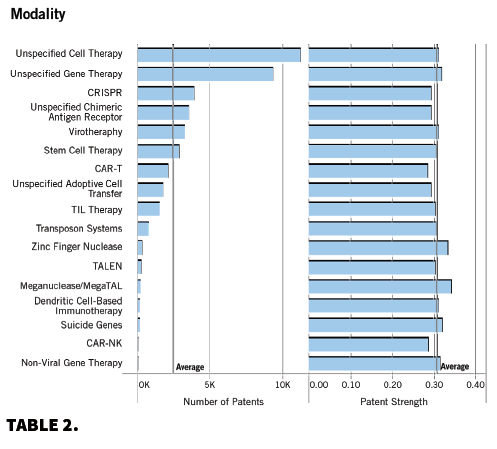
Cigna is introducing a program intended to protect participating organizations from the high cost of regenerative medicine. It will start with Luxturna for a version of inherited retinal disease, and Novartis’ Zolgensma (onasemnogene abeparvovec-xioi) aimed at treating spinal muscular atrophy in children under two years old.
Cigna’s Embarc Benefit Protection program aims to remove out-of-pocket payments related to the cost of the therapies. Health plans that adopt Embarc will pay a per-member, per-month fee to participate in a gene therapy network. Physicians will submit prior authorization for the drugs, but once approved, a patient will not be charged a copay.
Next page: New discoveries through CRISPR
CRISPR gaining early attention
CRISPR (clustered regularly interspaced short palindromic repeats) is evolving into a robust genome editing tool, making the process more efficient and transforming genome editing studies. CRISPR represents DNA sequences in the genomes of bacteria and other organisms. Even though it is in its early stages, interest in CRISPR technology is growing strongly, as evidenced by the increasing number of patents filed and research undertaken, according to Signals Analytics. CRISPR research has received almost $2 billion in funding .
Early this year, Locus Biosciences and Janssen inked an agreement that began moving CRISPR down a novel path. Locus is commercializing research developed by scientists at North Carolina State University involving Cas3 proteins, which eat up DNA, instead of editing the material like the more well-known Cas9-based CRISPR technique. Cas3 removes DNA strains, acting like a shredder, unlike single sequence-targeting Cas9. The system is seen by some as potentially leading to a cure for viral diseases.
The Janssen-Locus agreement gives Janssen an exclusive license to develop, manufacture, and commercialize CRISPR-Cas3-enhanced products, which attack bad bacteria, to treat respiratory and other organ infections. Locus’ lead program targeting Escherichia coli is entering clinical development, with a Phase Ib clinical trial in patients colonized with E. coli in their urinary tracts.
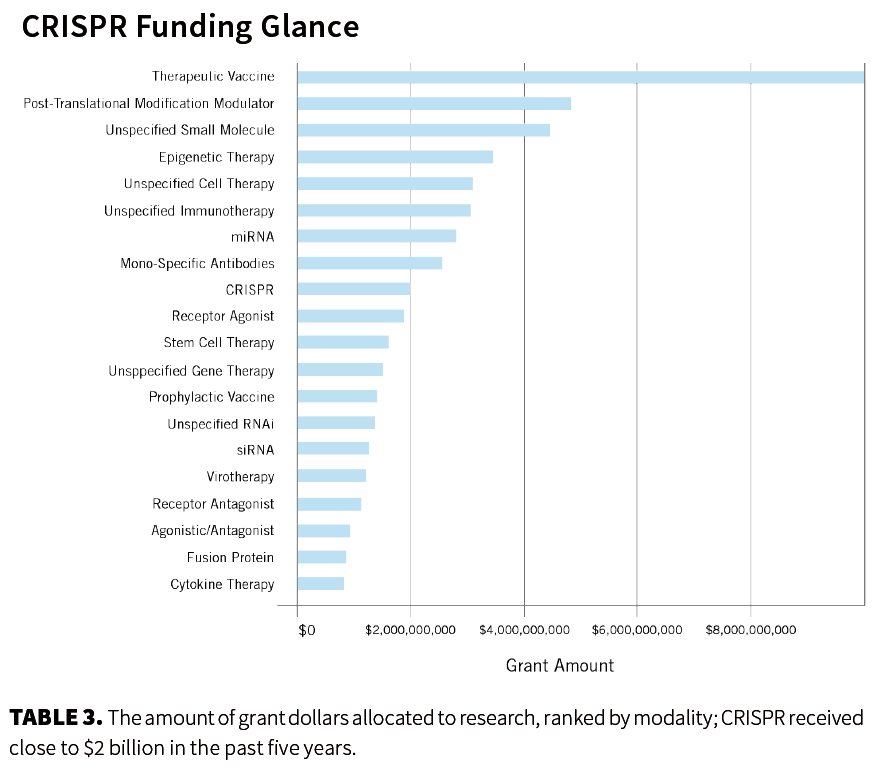
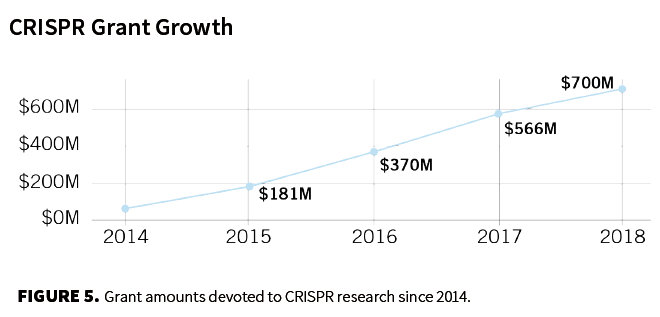
Meanwhile, CRISPR Therapeutics and Vertex Pharmaceuticals are developing CTX001, an investigational, autologous, CRISPR-Cas9 gene-edited hematopoietic stem cell therapy. It is under evaluation for patients suffering from severe hemoglobinopathies. The first patient has been treated with CTX001 in a Phase I/II clinical study of patients with transfusion-dependent beta thalassemia.
The partners also are investigating CTX001 for treating severe sickle cell disease. The first patient has been enrolled in a Phase I/II clinical study in the US and will be infused with CTX001. Vertex and CRISPR Therapeutics have also begun a trial to use CRISPR-edited T cells to treat non-responsive or relapsed non-Hodgkin’s lymphoma. Scientists intend to edit the cells using CRISPR to target CD-19, a protein that marks B cells, which turn malignant in certain non-Hodgkin’s lymphoma.
click to enlarge
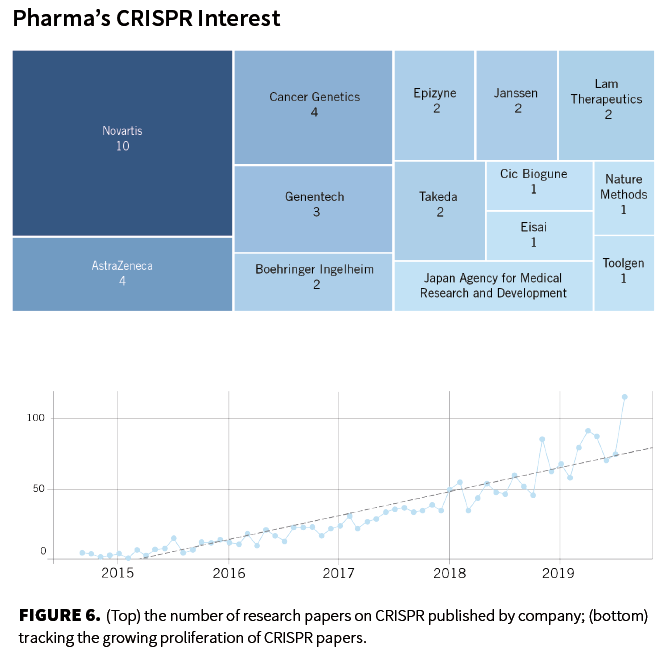
Researchers at Mammoth Biosciences are pursuing the development of an in-home genetic diagnostic for detecting illnesses at the point of care. In March, the company received an exclusive license from the University of California, Berkeley to a new CRISPR protein, Cas14, which contains up to 700 amino acids and is half the size of other Cas proteins. Cas14 makes it possible to find double-stranded and single-stranded DNA, as well as RNA. Using the Cas14 protein, Mammoth scientists are better able to analyze and detect a virus or bacteria.
On the academic side, Cas3 research is ongoing at the University of Michigan, Duke University, and Cornell University, among other institutions.
Next page: New fronts in heart disease fight
A new emphasis on cardiovascular disease
The statistics speak for themselves. More than 600,000 people die of heart disease in the US annually, according to the Centers for Disease Control and Prevention (CDC), and is the leading cause of death for men and women. High blood pressure, high cholesterol, and smoking are key risk factors, and almost half of Americans have at least one of those.
While there may be a variety of drugs already on the market for treating hypertension, high cholesterol levels, and other contributors to heart disease, there is no shortage of research on new fronts in cardiovascular disease (CVD). Signals Analytics reports that hypertension, congestive heart failure, and atherosclerosis are the most researched conditions in preclinical phases. Preclinical research in the areas of hypertension and hemophilia is strong. Key players include Bayer and Pfizer, among several others.
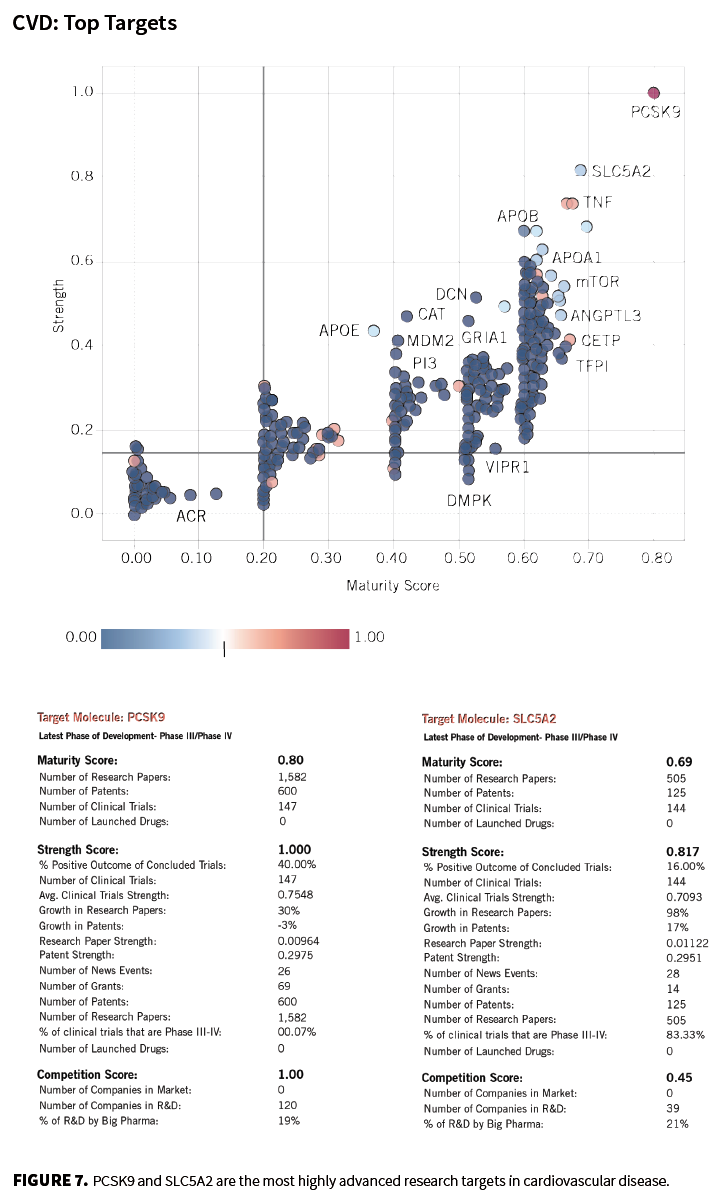
Bayer has a number of clinical programs targeting such areas as pulmonary hypertension, heart failure, peripheral artery disease, thrombosis, and peripheral artery disease, spread across Phase I to III clinical trials.
Greater levels of plasma vasopressin, which mediates water retention, are associated with the progression of congestive heart failure. Attempting to combat this, Bayer is developing BAY 1753011, a novel, dual-acting vasopressin receptor antagonist. The company is recruiting for a multicenter, randomized, double-blind, active and placebo-controlled study of BAY1753011 in patients who have congestive heart failure.
Earlier this year, Pfizer received FDA approval for two formulations of tafamidis-based drugs, including a first for treating cardiomyopathy of wild-type or hereditary transthyretin-mediated amyloidosis (ATTR-CM). Vyndaqel (tafamidis meglumine) is the first US drug approved to treat this rare condition. The agency also cleared Vyndamax, another formulation of tafamidis. The two drugs are approved for ATTR-CM in adults to reduce cardiovascular mortality and cardiovascular-related hospitalization. Vyndaqel has been on the market in Europe for treating polyneuropathy since 2011. Vyndamax is a free acid version of the drug.
In March, Novo Nordisk filed for FDA approval of oral semaglutide, which would be the first glucagon-like
Click to enlarge

peptide-1 (GLP-1) receptor agonist delivered in pill form. Novo also filed for a new cardiovascular indication for its once-a-week injectable form of semaglutide, which was granted approval from FDA in late 2017. The weekly injectable GLP-1 receptor agonist is marketed as Ozempic. Novo submitted two NDAs. One seeks approval to improve blood glucose to treat type 2 diabetes, and the other is pursuing an indication to reduce major adverse events, including heart attacks, strokes, and cardiovascular-related death, in adults with type 2 diabetes and established CVD. (See Novo’s CVD pipeline snapshot).
Meanwhile, FDA has given fast-track designation for AstraZeneca’s SGLT2 inhibitor dapagliflozin (Farxiga) for patients who have chronic kidney disease, to delay progression of renal failure and prevent cardiovascular and renal death. In August, the big pharma said that Farxiga met the primary composite
Click to enlarge
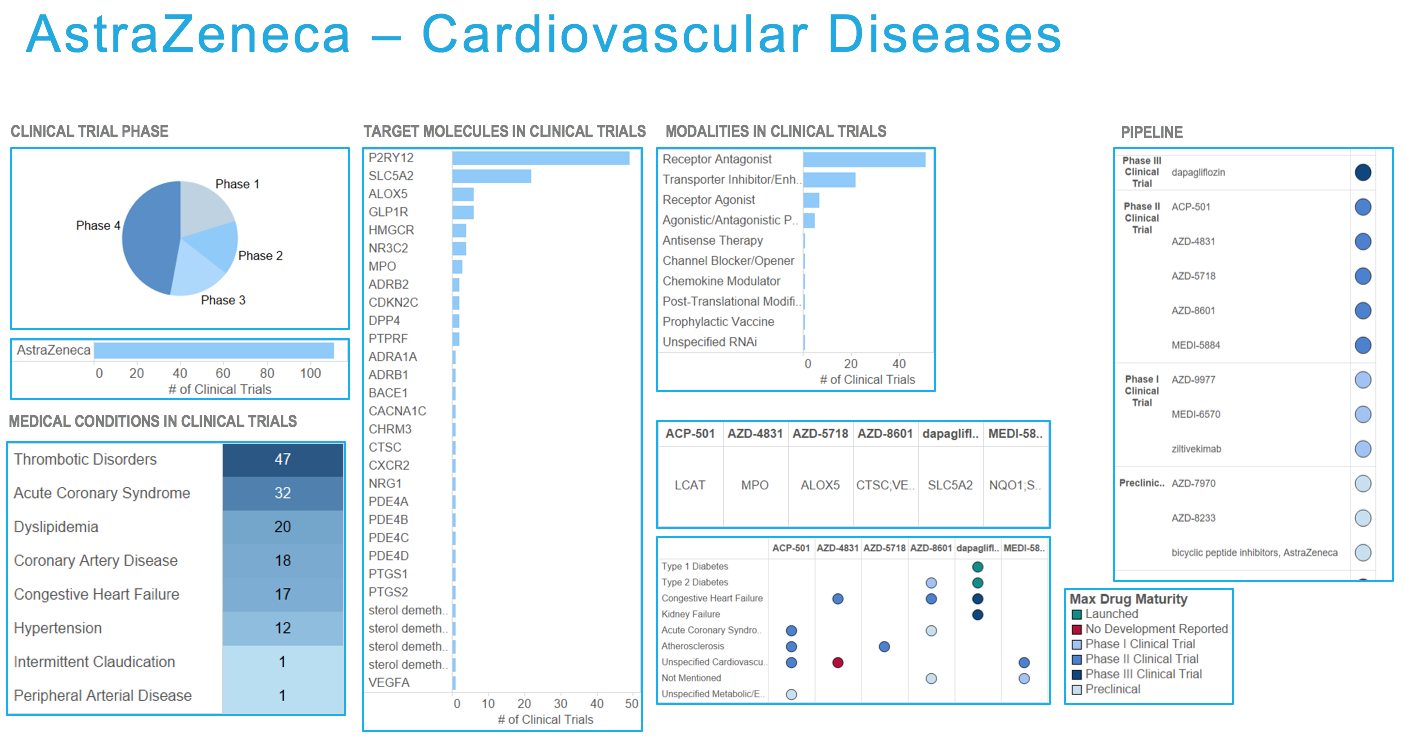
endpoint in the landmark Phase III DAPA-HF trial, with a statistically significant and clinically meaningful reduction of cardiovascular death or the worsening of heart failure. (See AstraZeneca’s CVD pipeline snapshot).
Alnylam is evaluating inclisiran, formerly PCSK9si or ALN-PCSsc, an experimental RNAi therapeutic currently in Phase II Orion studies for hypercholesterolemia. The Medicines Company licensed the rights to inclisiran from Alnylam, and a Phase III clinical trial showed that the drug has met its primary endpoint. An NDA is planned.
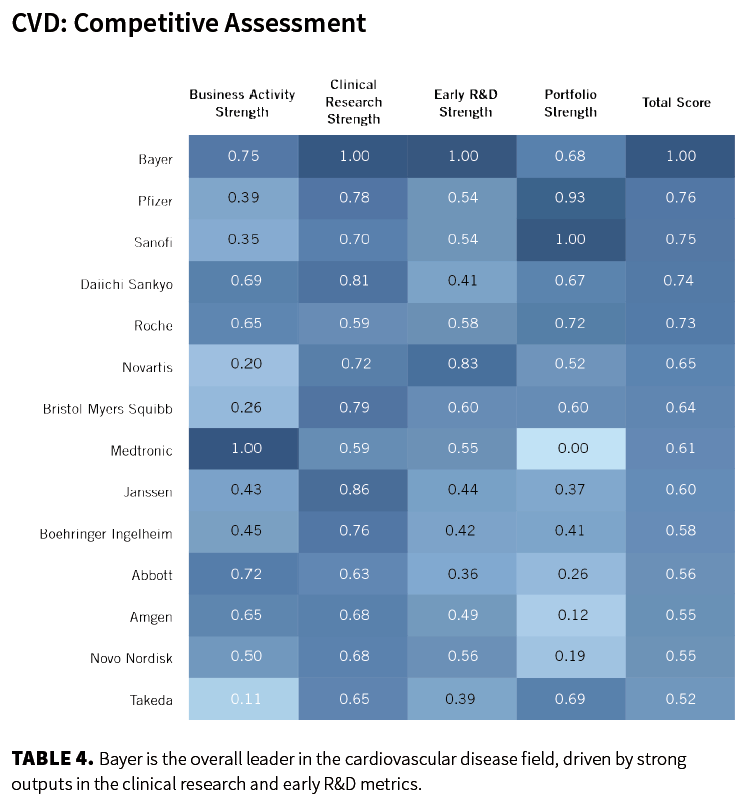
In August, Germany-based 4TEEN4 Pharmaceuticals, formerly Sphingotec Therapeutics GmbH, reported preclinical data on its lead product, Procizumab, a therapeutic antibody targeting circulating dipeptidyl peptidase 3 (DPP3) for treating patients with acute myocardial depression, including acute heart failure and cardiogenic shock. Procizumab, a humanized monoclonal antibody designed to block peptidase activity of DPP3, immediately normalized heart and kidney function in a preclinical model for acute heart failure.
Also in August, Idorsia announced results of a Phase II study involving aprocitentan, an orally active dual endothelin receptor antagonist (ERA). Aprocitentan is under investigation for treating patients whose blood pressure is uncontrolled, despite receiving triple antihypertensive medications (resistant hypertension).
Click to enlarge

Developed with Janssen, the drug is intended to lower blood pressure by blocking endothelin receptors in cells lining the blood vessels. Aprocitentan lowered blood pressure in hypertensive patients in the Phase II trial, and is also in an ongoing Phase III study for treating people with uncontrollable hypertension. (See Idorsia's hypertension pipeline snapshot).
On a down side for cardiology, Sanofi is cutting more than 450 positions in France and Germany, and is terminating new in-house cardiology research programs, as part of a restructuring. Sanofi executives say the organization is focusing on potential therapies licensed from partners and on remaining internal efforts. The company is transitioning more to immuno-oncology and gene therapies.
Next page: The CAR-T evolution
CAR-T continues to transform therapy
It’s been almost three decades since chimeric antigen receptors (CARs) were first reported scientifically. And it’s only in the last few years that researchers have gained ground in transforming the science into therapies for patients in real-world settings.
These efforts have begun to pay off, as seen in the 2017 FDA approvals of Novartis’ Kymriah for treating acute lymphoblastic leukemia (ALL) in certain pediatric and young patients, and Gilead Sciences/Kite Pharma’s Yescarta, for adults with certain large B-cell lymphomas.
There are a number of ongoing oncology clinical trials involving CAR-T, according to data provided by Signals Analytics. Researchers have filed and received a number of patents and have authored several scientific papers.
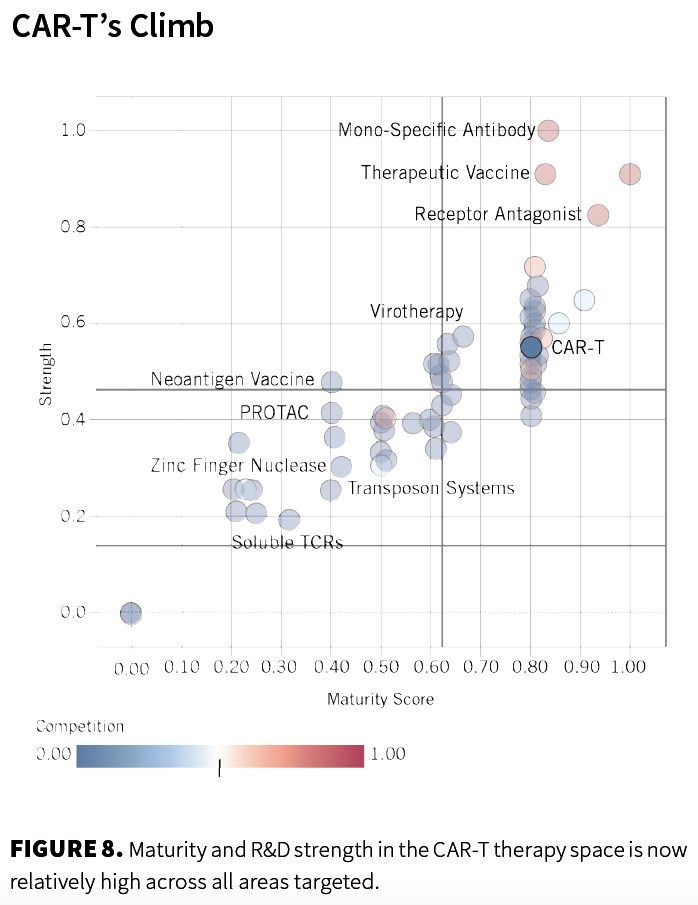
Among concerns, though, have been access and the affordability of CAR-T therapies, some of which can cost more than $1 million per patient. But concerns were somewhat allayed in midsummer when the Centers for Medicare and Medicaid Services (CMS) announced that it would cover CAR-T for Medicare recipients; the coverage began on Oct. 1. Additionally, CMS pulled back on a proposal to make hospitals collect and report data on patient outcomes over a long period of time. And Medicare coverage will include CAR-T cell therapies for off-label uses, which CMS-approved compendia recommend.
It is possible that the new policy could speed adoption of CAR-T drugs, something Gilead is hoping for after its $12 billion purchase of Kite in 2017. Gilead is focusing on cell therapy, but Yescarta only generated about $260 million in revenue in 2018. More recently, a pivotal Zuma-1 study indicated that the therapy brings better results in older patients, with those 65 and older experiencing a 92% overall response rate at a median 27.1 months, compared with 81% among patients younger than 65. Three-quarters of the older group achieved a complete response, compared with 53% for those younger than 65.
The findings are important because it is usually older patients with refractory large B-cell lymphoma who have exhausted treatment options and continue to face progressive disease.
In addition, Gilead has published data on an investigational CAR-T, KTE-X19, for adults with relapsed or refractory acute lymphoblastic leukemia. In Phase I of the two-phase Zuma-3 trial, patients experienced a high rate of response to a single infusion. The Phase II program for KTE-X19 is ongoing.
Two more CAR-T therapies could be commercialized in 2020. In July, Celgene indicated that it intends to file for FDA approval for lisocabtagene maraleucel (liso-cel) in diffuse large B-cell lymphoma (DLBCL) late this year.
Also, Celgene and bluebird bio’s CAR-T candidate, bb2121, has shown promise for treating multiple melanoma, where new therapies have prolonged survival but have failed to prevent relapse. Celgene anticipates filing for regulatory approval of bb2121, also known as idecabtagene vicleucel (ide-cel), in multiple myeloma during the first half of 2020.
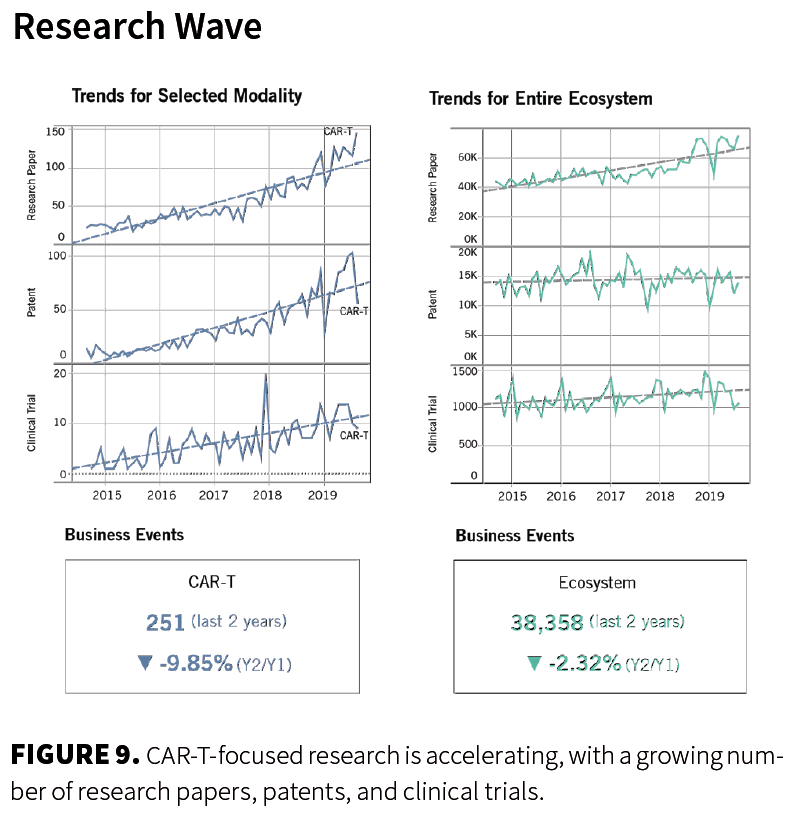
In September, Celyad announced the successful administration of CYAD-01, produced with the company’s OptimAb manufacturing process. CYAD-01 is an investigational CAR-T therapy in which a patient’s T cells are engineered to express a CAR based on NKG2D, a receptor expressed on natural killer (NK) cells that
Click to enlarge

binds to eight stress-induced ligands expressed on tumor cells. CYAD-01 is being evaluated in several Phase I trials to assess safety and clinical activity for treating hematological malignancies.
The OptimAb manufacturing process uses a shortened cell culture and incorporates a selective PI3K inhibitor to produce a product enriched for T cells with a memory-like phenotype. Preclinical data show that CYAD-01 produced using this process optimizes anti-tumor activity in an aggressive acute myeloid leukemia model. (See Celyad’s CAR-T pipeline snapshot above).
CarsGEN Therapeutics’ pipeline includes more than 11 CAR-T candidates, including products targeting GPC3, CD19, BCMA, Claudin18.2, and EGFR/EGFRvIII. Five are at the clinical trial stage, and some are investigational new drug (IND)-approved. (See CarsGEN's pipeline snapshot).
Click to enlarge
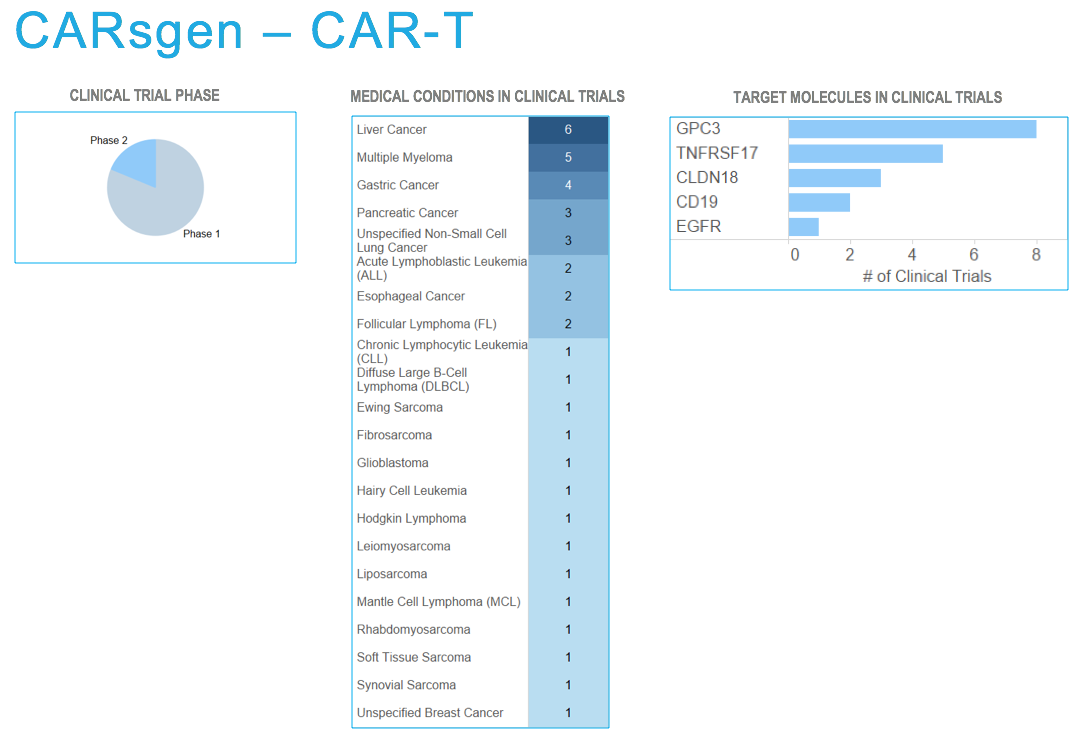
Cellectis is in the early stages of developing CAR-T therapies that target blood and bone marrow cancers, including ALL and B-cell ALL, acute myeloid leukemia, multiple myeloma, and Hodgkin’s lymphoma.
Amgen’s AMG 119 is a delta-like ligand-targeting CAR-T therapy under investigation as a treatment for small-cell lung cancer. The ligand is
Click to enlarge
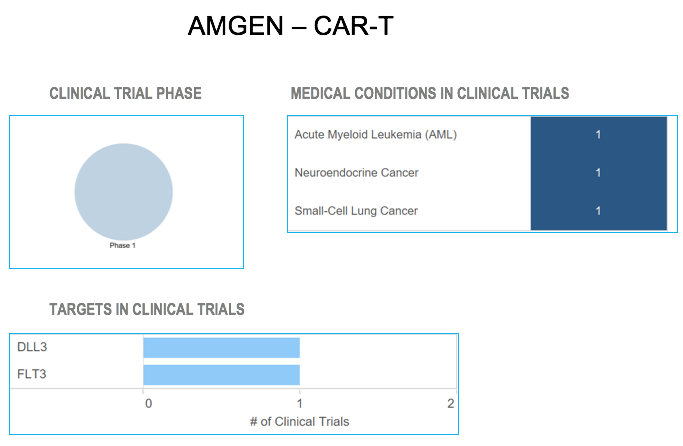
expressed in most small-cell lung cancer tumors. (See Amgen’s CAR-T pipeline snapshot).
The efforts of Shanghai-based biotech Innovative Cellular Therapeutics involving CAR-T may lead to a treatment for solid tumors. The company’s lead program, ICTCAR014, targets CD19 and programmed cell death protein 1 (PD-1). The latter is a protein on the surface of cells that helps regulate the immune system’s response to cells by down-regulating the immune system and promoting self-tolerance by suppressing T-cell inflammatory activity. This prevents the immune system from killing cancer cells.
PD-1 inhibitors activate the immune system to attack tumors. ICTCAR014 is in preclinical development for treating non-Hodgkin’s lymphoma. But the basis for the drug is also under development for treating solid tumors. The company’s solid tumor CAR-T preclinical and clinical pipelines include therapies for treating thyroid, breast, pancreatic, prostate, and urothelial cancers.
Among Atara Biotherapeutics’ CAR-T candidates is ATA2271, targeting mesothelin, which is expressed at high levels on the surface of cells in aggressive solid tumors, including mesothelioma, triple-negative breast cancer, esophageal cancer, pancreatic cancer, and non-small cell lung cancer. The drug is in preclinical development.
In August, Celgene and Germany-based Immatics Biotechnologies agreed to develop adoptive cell therapies targeting several cancers. The companies are using Immatics’ T-cell receptor engineered T-cel
Click to enlarge
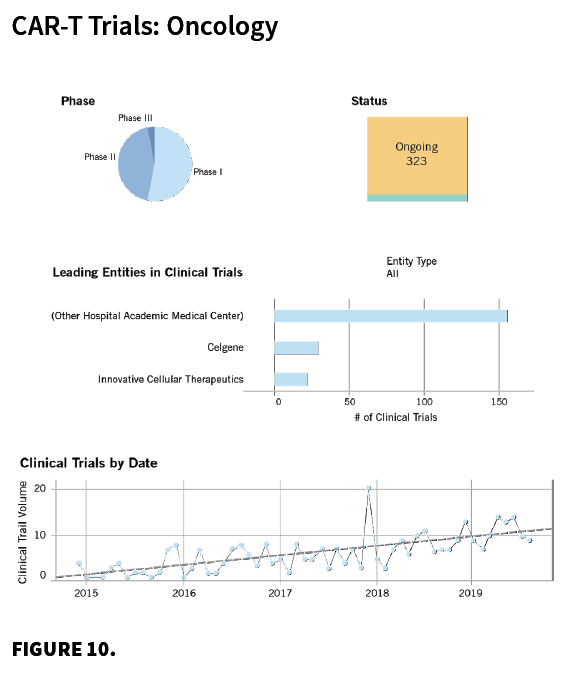
l therapy (TCR-T) programs to target solid tumors.
Also active on the solid tumor front is Tarveda Therapeutics. The company’s PEN-866 is the first miniature drug conjugate from Tarveda’s Heat Shock Protein 90 binding conjugate platform. It is under evaluation in an ongoing Phase I/IIa clinical trial in patients with advanced solid tumors. Tarveda’s PEN-221 is being tested in a Phase I/IIa clinical trial in somatostatin receptor 2 (SSTR2)-positive neuroendocrine tumors. The drug is intended to rapidly penetrate deep into solid tumors where it is highly selective for SSTR2.
Amid efforts in CAR-T, another novel treatment paradigm for cancer-tumor agnostic therapies, which target genetic mutations independent of where a tumor is located-is beginning to reap results. Late last year, Bayer and Loxo Oncology received FDA approval for Vitrakvi (larotrectinib) in adult and pediatric patients with solid tumors that have a neurotrophic receptor tyrosine kinase (NTRK) gene fusion without a known acquired resistance mutation; and in June, Japan’s Ministry of Health, Labor and Welfare (MHLW) cleared Roche’s Rozlytrek (entrectinib) for NTRK fusion-positive, advanced recurrent solid tumors. FDA has granted Amgen’s AMG 510 orphan-drug designation targeting KRASG12C-positive non-small cell lung and colorectal cancers. Reportedly the first KRASG12C inhibitor to reach the clinical stage, first-in-human results indicate preliminary safety, tolerability data, and antitumor activity in KRAS-mutant solid tumors.
Beyond cancer for CAR-T: Autoimmune diseases
Spun out of research at the University of Pennsylvania, biotech firm Cabaletta has raised nearly $40 million to develop CAR-T-like cell therapies for autoimmune diseases. The company has an exclusive license agreement and two multi-year research agreements with the university to discover and develop autoimmune CAR-T therapies. In October, Cabaletta received FDA clearance for its IND application to start a first-in-human clinical trial of desmoglein 3 chimeric autoantibody receptor T cells in patients with mucosal pemphigus vulgaris. The objective is to determine the safety and tolerability of DSG3-CAART. The company expects to enroll the first patient in 2020.
Atara is developing treatments for patients with cancer, autoimmune, and viral diseases. Atara’s allogeneic T-cell immunotherapy candidate, tabelecleucel (tab-cel), previously known as ATA129, is being developed for treating patients with Epstein-Barr virus (EBV)-associated post-transplant lymphoproliferative disorder, as well as other EBV-associated hematologic and solid tumors, including nasopharyngeal carcinoma. Atara is also developing off-the-shelf, allogeneic ATA188 and autologous ATA190 T-cell immunotherapies using a
Click to enlarge
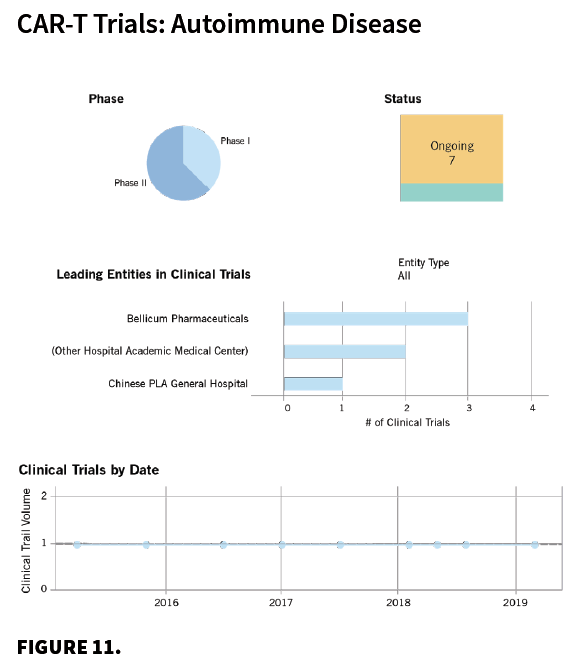
complementary targeted antigen recognition technology for specific EBV antigens believed to be important for the potential treatment of multiple sclerosis.
Meanwhile, Syncona has invested more than $40 million in startup financing for Quell Therapeutics, a cell therapy company focusing on using regulatory T cells (Tregs) to treat immune system diseases. The UK-based life sciences venture capital firm is launching Quell to create CAR-T-related Treg therapies for solid organ transplant rejection and autoimmune and inflammatory diseases. Tregs are a new frontier in cell therapy.
Sangamo Therapeutics is expecting TX-200, its first CAR-Treg product candidate, to advance into the clinic as a hopeful treatment for HLA-A2 mismatched kidney transplantation rejection. The Treg cells also might be developed to treat autoimmune diseases.
In March, Atara and Memorial Sloan Kettering Cancer Center unveiled encouraging results from an ongoing Phase I clinical study (NCT02414269) of a mesothelin-targeted CAR-T immunotherapy for patients with mesothelin-associated malignant pleural solid tumors, primarily mesothelioma, who progressed after previous standard platinum-containing chemotherapy. Mesothelin-targeted, autologous CAR-T cells delivered regionally were well-tolerated and showed promising antitumor activity in combination with pembrolizumab, a PD-1 checkpoint inhibitor.
Arcellx is an early stage immuno-oncology company developing CAR-T therapy for cancer and other diseases. The company’s development pipeline includes two lead products in the IND-enabling stage. Its proprietary antigen-receptor complex T cell (ARC-T) platform technology is initially targeting cancer therapies, but has use in other non-oncology indications.
Next page: Opioid alternatives
Tackling the ongoing opioid challenge
The current crisis of opioid abuse and overdose is beginning to rival the destructiveness of the HIV/AIDS epidemic. Daily, more than 130 people die in the US after overdosing on opioids. Many biopharma companies are investing in new science intended to shift pain therapy approaches away from problematic opioids.
Signals Analytics reports that there are 640 ongoing clinical trials involving non-opioid nociceptive pain relief, most in Phase II or III. Among the companies leading R&D efforts in this area is Pfizer. In April, however, Pfizer and partner Eli Lilly suffered somewhat of a setback involving tanezumab, where increased rates of osteoarthritis and other skeletal side effects were reported in a Phase III trial. The study showed only limited pain-relief benefit when compared to non-steroidal anti-inflammatory drugs (NSAIDs).
Tanezumab is a novel group of pain therapeutics that target nerve growth factor. In the Phase III study, among those patients administered a 5 mg dose of tanezumab, about 6% experienced progressing osteoarthritis, a condition in which joint destruction can occur in less than a half year. Still, trial results showed that tanezumab effectively reduces pain and increases function.
Click to enlarge
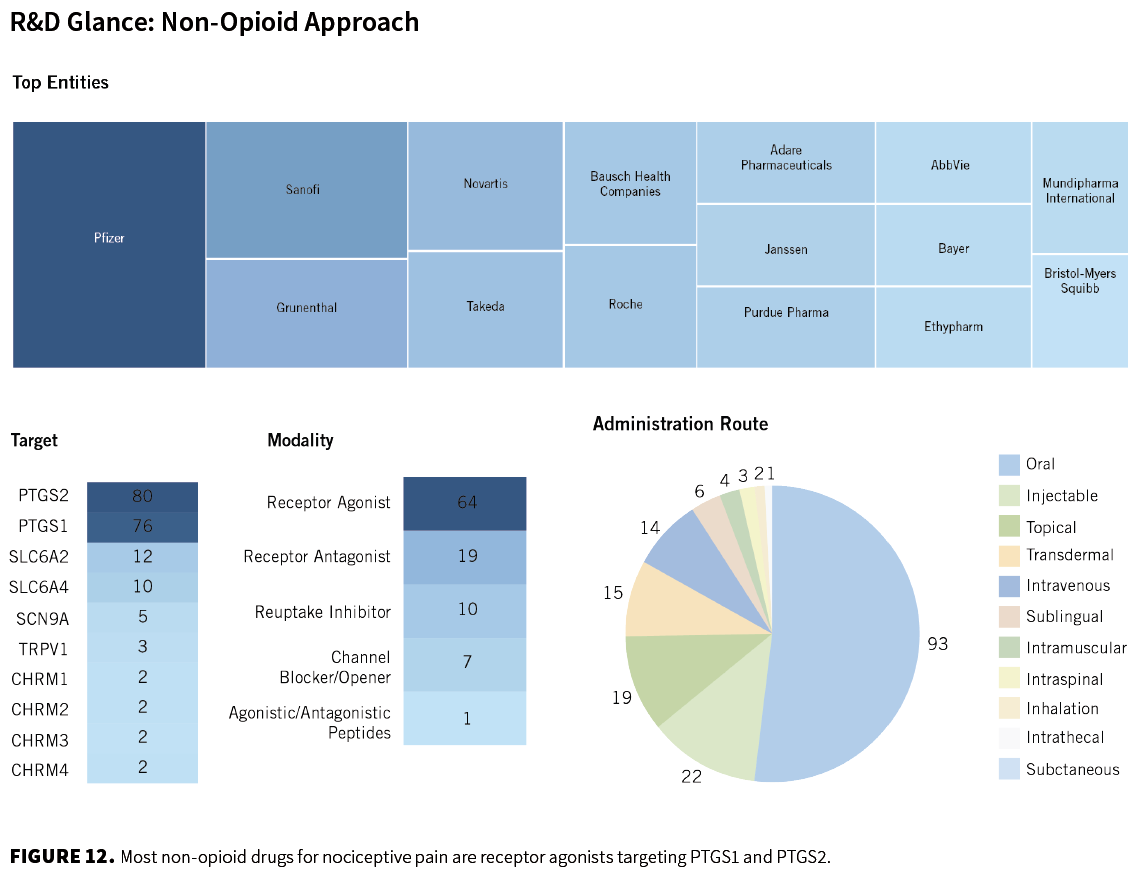
Also on the non-opioid pain treatment front, Teva and Regeneron Pharmaceuticals are working together, with more than 10,000 patients in Phase III trials for fasinumab, a competitor to tanezumab. In study findings released in July, fasinumab, a recombinant, fully-human anti-nerve-growth-factor antibody, was shown, at different dosages, to improve pain and physical function in patients who have osteoarthritis. The drug worked in those who had little benefit from previous analgesic therapy.
Nektar Therapeutics’ NKTR-181, which has been in Phase III, is a form of oxycodone to which is linked polyethylene glycol. For treating moderate-to-severe chronic low back pain, the candidate causes a slower release of dopamine. Over the summer, FDA delayed a planned advisory committee hearing on NKTR-181. But it appears that the agency has been delaying all advisory committee meetings involving opioid treatments as it forms new opioid approval policy guidelines. The NDA for NKTR-181 continues under review.
Click to enlarge
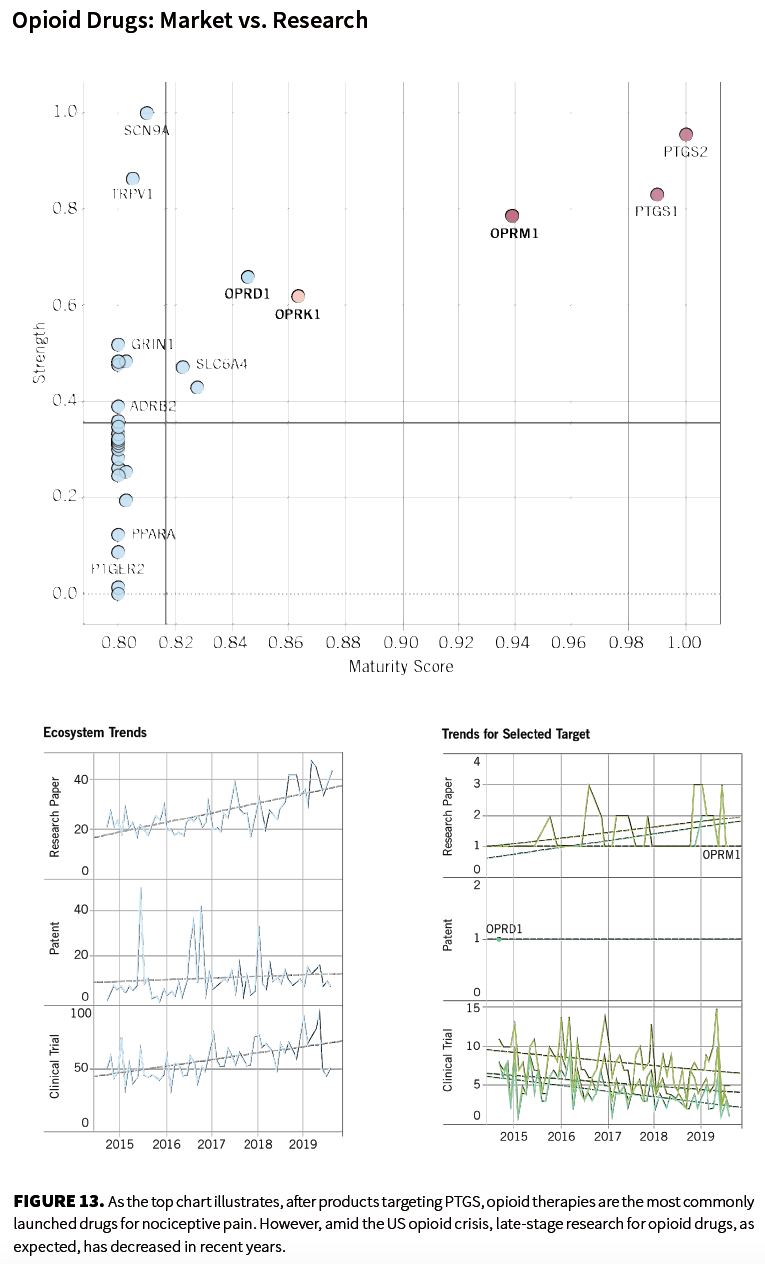
On a positive note, Heron Therapeutics’ HTX-011 reduced pain intensity and opioid consumption in a Phase III EPOCH 2 study for open inguinal hernia repair surgery with mesh. HTX-011 achieved all primary and key secondary endpoints, showing statistically significant reductions in pain intensity and the use of opioid rescue medications after surgery, as well as an increase in the proportion of opioid-free patients.
Tremeau Pharmaceuticals is initiating Phase III trials of TRM-201, or rofecoxib, for hemophilic

arthropathy, a serious orphan disease for which high-potency opioids are the current standard of care.
In June, Centrexion Therapeutics completed patient enrollment in its second pivotal trial, Victory-2, a randomized, double-blind, placebo-controlled, repeat-injection-at-six-months, 52-week study evaluating the efficacy and safety of intra-articular (IA) injections of CNTX-4975 in 332 participants with chronic moderate-to-severe knee osteoarthritis (OA) pain. CNTX-4975 is a synthetic, ultra-pure, IA injection of trans-capsaicin designed for injection directly into the site of pain. It harnesses the analgesic potential of capsaicin to provide durable and targeted pain relief, with onset of response by the second day after injection. In
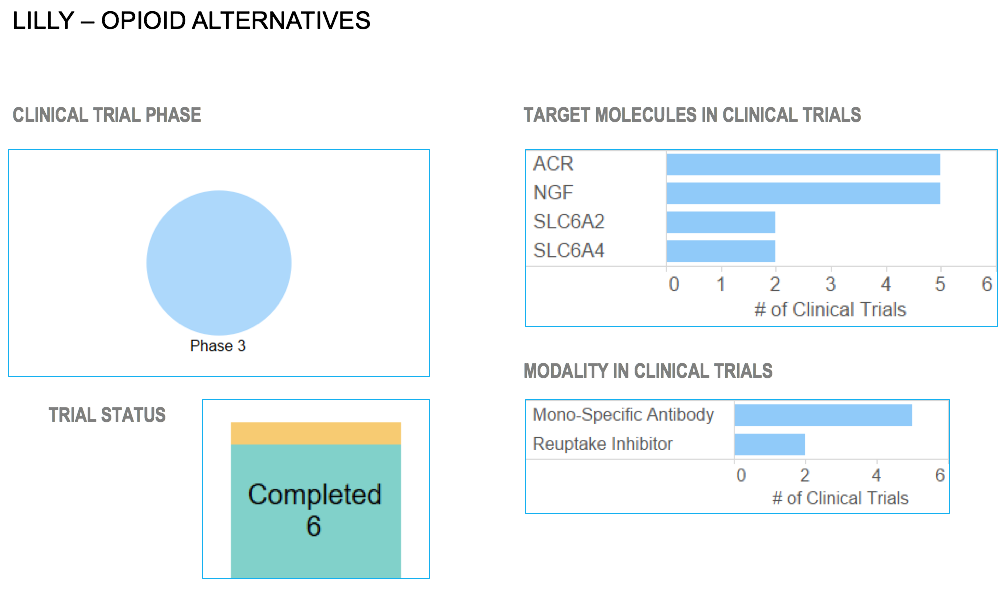
January 2018, CNTX-4975 received fast-track designation from FDA for treating moderate-to-severe pain associated with knee osteoarthritis.
In April, Teva received European Commission marketing authorization for Ajovy (fremanezumab-vfrm) 225 mg solution for injection in pre-filled syringe for the prophylaxis of migraine in adults who have at least four migraine days per month.
Ajovy is a humanized monoclonal antibody that binds to the calcitonin
Pfizer, Lilly, and Heron non-opioid pipeline glances; click on each to enlarge
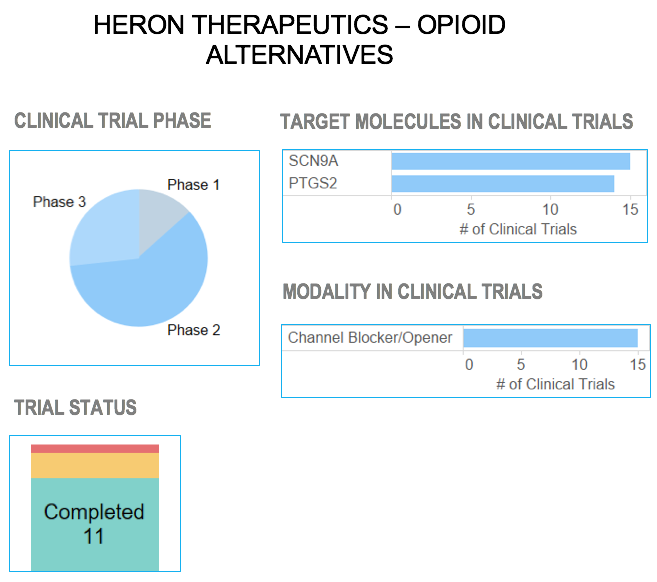
gene-related peptide (CGRP) ligand and blocks its binding to the receptor. The drug is approved in the European Union and US intended to prevent migraines, and offers both quarterly and monthly dosing options for the phrophylatic treatment of migraines.
US WorldMeds, whose Lucemyra (lofexidine hydrochloride) was approved by FDA in May 2018 to dampen withdrawal symptoms during the abrupt discontinuation of opioids in adults, is running a randomized, double-blind, placebo-controlled study on the safety and effectiveness of using Lucemyra when tapering down and withdrawing from opioid use.
Next page: The latest in Alzheimer's
Alzheimer’s frustration
Alzheimer’s disease is the most common form of dementia, and despite the best intentions of drug developers over the years, with many well-documented fits and starts, there is still no way to prevent the onset of the disease or halt its brain-ravaging progression.
According to the Medical Condition Score Card in Signals Analytics’ Pharma Playbook, which comparatively maps the scientific potential of a cohort of diseases, Alzheimer’s disease ranks highest in preclinical research strength among CNS therapy pursuits. However, there is little promising clinical evidence needed for commercializing therapies.
Click to enlarge

A recent white paper authored by Signals Analytics states that the complexity of treating Alzheimer’s, the controversy surrounding its underlying pathology, safety issues, and a lack of proven clinical efficacy have all contributed to the search for a cure being abandoned by many companies, including Lilly, AstraZeneca, Roche, Johnson & Johnson, and Pfizer. Still, there has been an increase of 147% in research papers
In March, Biogen and its partner Eisai Co. ended two late-stage trials of the human monoclonal antibody aducanumab. At the time, it marked a major setback in the quest to find a treatment. Aducanumab was one of the last tests of the belief that removing amyloid beta deposits from the brain of early disease-stage patients could hold therapeutic value. Such hope, however, was revived last month, with the surprise about-face by Biogen and Eisai, who based on discussions with FDA, now intend to file a biologics license application (BLA) for aducanumab early next year after considering a larger dataset analysis from the Phase III EMERGE study that showed significant reduction in clinical decline in a subset of patients receiving the drug.
Shanghai company Green Valley Pharmaceutical Co. is developing GV-971, a multi-targeting carbohydrate-based drug for treating patients with mild-to-moderate Alzheimer’s disease. It passed a Phase III clinical trial and is awaiting possible approval from China’s National Medical Products Administration.
Click to enlarge
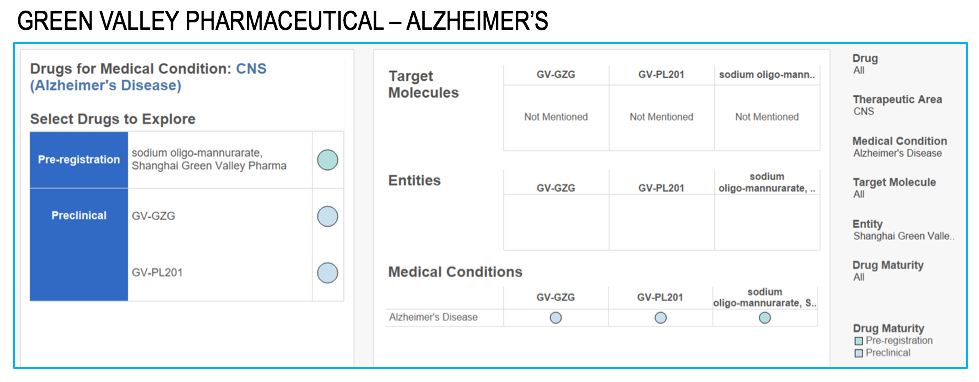
During the study, after 36 weeks of treatment, GV-971 significantly optimized the cognitive impairment of patients who had Alzheimer’s. (See Green Valley's AD pipeline snapshot).
Meanwhile, vTv Therapeutics is in Phase II trials with its drug candidate azeliragon. The orally bioavailable small molecule targets the receptor of advanced glycation endproducts (RAGE), an
Click to enlarge
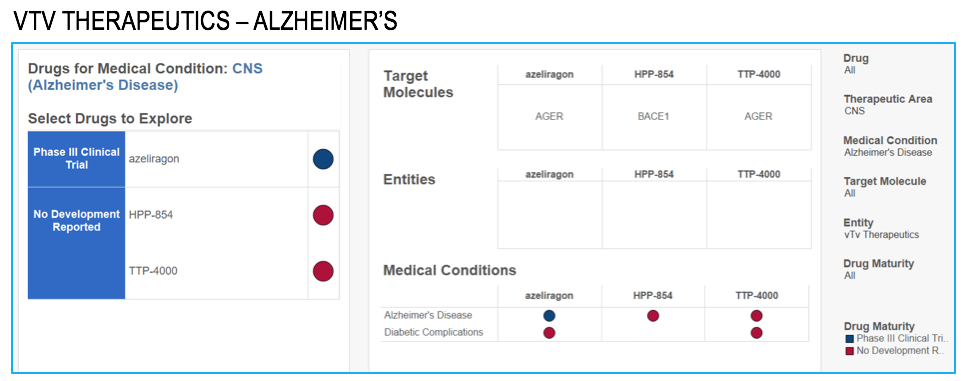
immunoglobulin-like cell surface receptor that overexpresses in those with Alzheimer’s. vTv will begin a Phase II/III study in mild Alzheimer’s disease patients with type 2 diabetes, with results possible next year. (See vTv's AD pipeline snapshot).
New York City-based biotech Oligomerix is in the early stages of developing a proprietary small molecule inhibitor and biomarker platform. The company is developing CNS small molecule lead compounds for neurodegenerative diseases intended to inhibit the formation of tau oligomers at the beginning of the aggregation process. Oligomerix’s biomarker effort is in the discovery stage, while its tau oligomer inhibitor program is in the preclinical stage.
FIGURE 15. Compared to other CNS diseases, preclinical research in Alzheimer's disease is very strong. The pace of clinical research in AD (also shown below) is considerably less, but, on average, is solid.
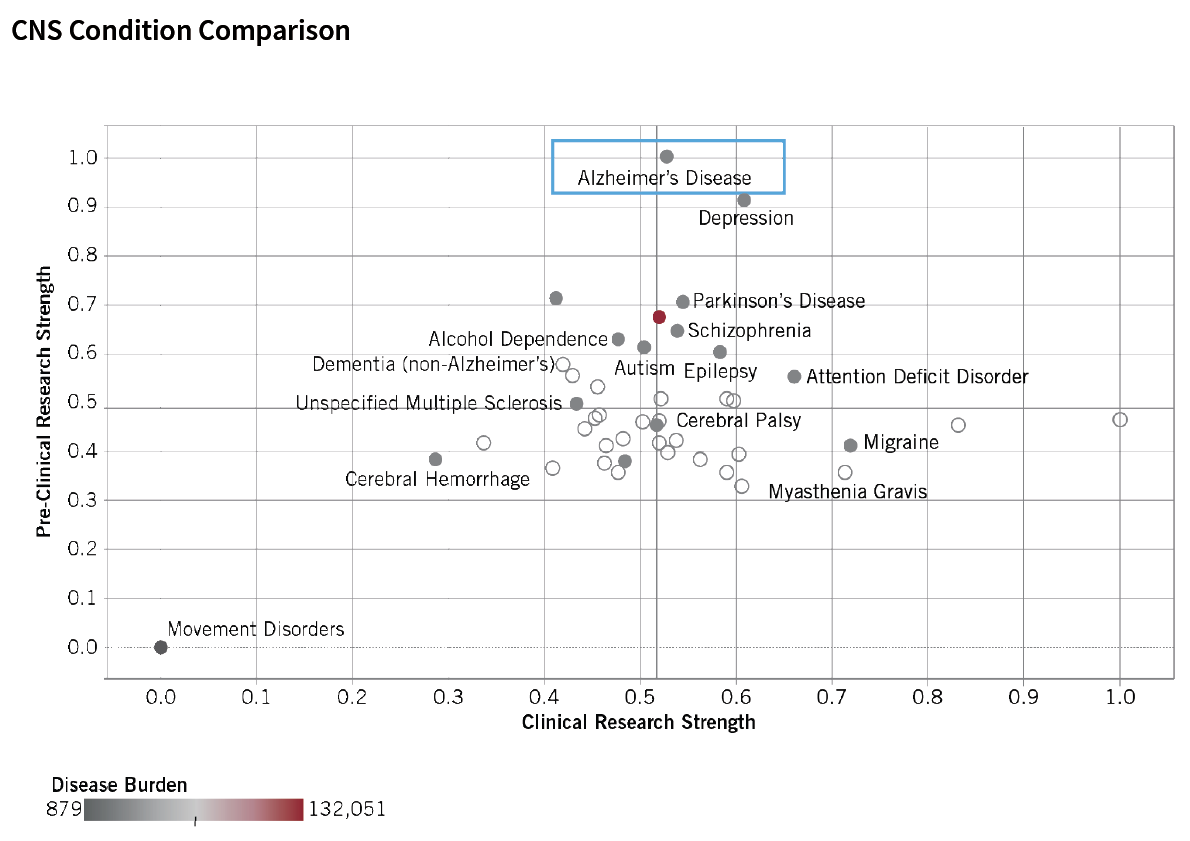

AC Immune is launching a Phase Ib/IIa clinical trial to evaluate its investigational anti-tau vaccine, ACI-35.030, as a potential disease-modifying treatment for Alzheimer’s disease and other tauopathies. The trial is a randomized, multicenter, double-blind, placebo-controlled study with a primary objective to assess the safety, tolerability, and immunogenicity of different doses of ACI-35.030 in patients with early-onset Alzheimer’s.
In new research, scientists at Temple University are linking dysfunctional changes in calcium transport by mitochondria, which are the energy-generating powerhouses of cells, to the progression of Alzheimer’s disease. Calcium transport into mitochondria reportedly plays an important role in many cellular functions and requires the involvement of multiple proteins to be carried out effectively.
Joseph Constance is an independent writer and analyst based in New Jersey. He can be reached at jacpub@gmail.com

Addressing Disparities in Psoriasis Trials: Takeda's Strategies for Inclusivity in Clinical Research
April 14th 2025LaShell Robinson, Head of Global Feasibility and Trial Equity at Takeda, speaks about the company's strategies to engage patients in underrepresented populations in its phase III psoriasis trials.
Key Findings of the NIAGARA and HIMALAYA Trials
November 8th 2024In this episode of the Pharmaceutical Executive podcast, Shubh Goel, head of immuno-oncology, gastrointestinal tumors, US oncology business unit, AstraZeneca, discusses the findings of the NIAGARA trial in bladder cancer and the significance of the five-year overall survival data from the HIMALAYA trial, particularly the long-term efficacy of the STRIDE regimen for unresectable liver cancer.
Regeneron, Roche Launch Major US Expansion Plans to Meet Growing Demand for Biologics and Innovation
April 22nd 2025With combined investments exceeding $53 billion, both companies are deepening their US presence through expanded biologics production, gene therapy capabilities, and next generation R&D centers.